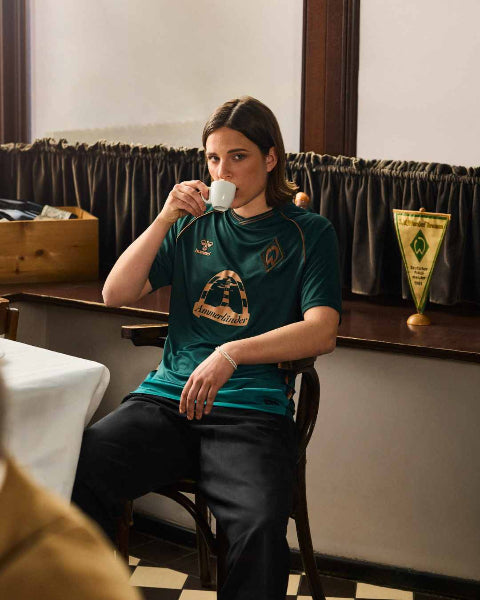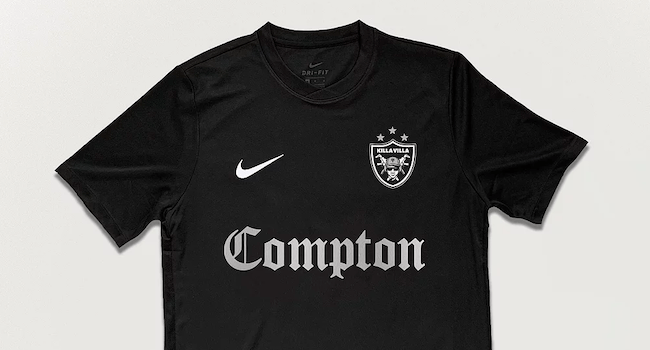Recently added
Vintage shirts
Concept kits
Legends
How to grow a collection on a budget
by Phil Delves September 09, 2022 5 min read

If I could go back in time and give my past-self one piece of advice, it would be to start buying football shirts, ASAP. No matter how old you are this would be, on some level, a good piece of advice. Had I bought even just a few more kits from my childhood (ideally in adults sizes!) I’d be sitting on either a tidy little collection of the funds to be able to afford maybe half a player spec shirt.
For anyone wanting to get in on ‘the game’ now though in 2022, the prospect is daunting. Shirts are very expensive at all levels, and though there’s always the end-of-season sales to look forward to the thought of actually putting together a collection of multiple shirts sounds like a pipedream for anyone who doesn’t have a huge amount of disposable income.
Despite this daunting prospect, I wanted to offer up some practical tips for how to grow a collection on a budget. This should hopefully apply not only to newcomers to the football shirt space but veterans who are feeling a bit disenfranchised with the current market.

—
There will always be another shirt
Without wanting to sound trite, I’ll start with a piece of advice which has stuck with me ever since I saw it: there will always be another shirt.
We are bombarded with sales every single day, we’ve never had more choice. And yet when a good deal is offered up by a collector on Twitter or you stumble on a bargain auction that’s just about to close on eBay, it’s ok to walk away if money is tight at the moment or if you simply aren’t 100% about a purchase.
Too often I’ve been in situations where I’ve bought a shirt because “it’s a good deal”, and that’s not a good move the vast majority of the time. Perhaps the deal is amazing, but football shirts are ultimately not a necessity when there are bills to be paid.
I appreciate this is maybe a bit of a downer and not exactly exciting, but it’s something I know I wish I’d heard earlier on in my collecting journey. Hopefully it can help a couple of you too!
Second opinions are like gold dust
When negotiating the endless sea of deals and offers it can be incredibly difficult to both know if a deal is actually good in the first place and crucially if a shirt is even real!
We’ve written several blogs about spotting fakes which will be useful further reading on this area, but nothing brings peace of mind like a trusted fellow collector who can offer their two cents on a listing. It sounds obvious but if you don’t have any contacts like this spend time in the community! Whether it’s on Twitter, Instagram or another platform, take time to contribute to the discussion and connect with fellow geeks. 9 times out of 10 people will be happy to help, but as always you’re best establishing those relationships first before blindly sliding into DM’s asking if a kit is fake or not.

A second opinion is huge in the area of prices, too. Fakes can often be easily identified, but knowing if a price is actually good or not takes a lot of time. The more time you spend looking for a certain kind of shirt the more you’ll be able to get a handle on expected prices for things, so naturally if you know someone who collects 90s Serie A shirts they’ll be ideal for getting a second opinion on that 90s Inter Milan away shirt you’ve seen.
Ultimately when shopping on a budget you want to take extra care before blindly pulling the trigger, so don’t skimp over this step!
Sell to buy
For many collectors the idea of selling any of their shirts is heresy. The ‘traditional’ approach of slowly accumulating more and more shirts over time has been and will always be a popular way of going about things, but one thing I’ve realised more and more in my personal journey is that you can get where you want to go as a collector by taking a more pragmatic approach.
If you see a shirt you like, especially one that isn’t in the end of season sales or anything like that, look at your current collection. Is there a shirt you picked up last year which you haven’t warmed to since owning it? Perhaps the details don’t quite pop in person, or it just didn’t fit well. That same shirt could effectively be a down payment for that newer shirt which looks a little bit out of price range.
If you are going to take this approach, I’d advise that you should still keep some of your kits. I’ve heard many stories of people who have regretted selling their kits and only had to buy them back for more money than they originally paid. This sort of risk comes with the territory, and you’ll never be able to completely avoid regret if you do sell shirts. Give yourself the best chance though by carefully considering which shirts you sell on, and also keeping a section of your collection set aside from the ‘trade block’.
Global trade deal

Probably my favourite way to grow a collection on a budget is to trade with other collectors. Strictly speaking most trades won’t net you more shirts numbers wise, but trading offers you a chance to pick up new shirts at virtually no extra cost.
I’ve been in several situations as a collector where I’ve wanted to pick up a shirt abroad but I’ve been unable to because the club doesn’t ship to the UK. Similarly there have been shirts I’ve wanted to buy but money has been tight at the particular time. Trading can open those doors by allowing you to pass on shirts to another collector in exchange for a shirt you could otherwise not buy, or would otherwise find it difficult to buy.
Again, if you only ever traded you’d struggle to actually grow a collection numerically, but for many collectors the buzz largely comes from the thrill of the chase, those moments before owning the shirt before it arrives through your doorstep. In that sense trading is a great route, especially for those shirts we talked about previously which were potentially going to be sold anyway.
You’d be surprised what people are willing to trade for, also. In many of my trades with other collectors based outside the UK, some of my non-league English club shirts have been as sought after as shirts from bigger clubs! And similarly, I’ve enjoyed getting my hands on lower league U.S. or Argentinian club shirts for example which weren’t on the market here in the UK, thanks to a trade.
The best way to go about building a trade network is to be active on social media and to seek to help out collectors who need a proxy (someone willing to receive and send on a shirt). As you’re willing to help others, there’ll be opportunities to ask for a return of the favour. You can always make trades a regular option when discussing buying or selling shirts with other collectors. Many collectors will be willing to entertain trade offers, or shirts + cash offers, so consider that as a way to effectively spend less cash but still receive new shirts.
Phil Delves
As Head of Content, Phil is the creative playmaker of the team, covering every angle of football shirt news in our blogs and weekly Newsletter. Whether it's telling your fakes from your authentics, or deep dives into the newest football shirts designs, Phil will have all your football shirt content needs covered.
Sidebar
- Premier League football shirts
-
Other English clubs
- Birmingham City
- Blackburn Rovers
- Charlton Athletic
- Coventry City
- Derby County
- Hull City
- Ipswich Town
- Leicester City
- Middlesbrough
- Millwall
- Norwich City
- Portsmouth
- Preston North End
- Queens Park Rangers
- Sheffield United
- Sheffield Wednesday
- Southampton
- Stoke City
- Swansea City
- Watford
- West Bromwich Albion
- Scottish clubs
- Italian club shirts
- Spanish club shirts
- German club shirts
- International
- French club shirts
- Rest of the world
-
Legends
- Adriano
- Alessandro Del Piero
- Andrey Arshavin
- Alvaro Recoba
- Bobby Moore
- Bryan Robson
- Bukayo Saka
- Clarence Seedorf
- Cristian Vieri
- Cristiano Ronaldo
- David Beckham
- David James
- David Seaman
- David Ginola
- Dennis Wise
- Dennis Bergkamp
- Didier Drogba
- Dimitar Berbatov
- Diego Maradona
- Edgar Davids
- Eric Cantona
- Fernando Torres
- Freddie Ljungberg
- Gabriel Batistuta
- Gianluca Vialli
- Gianluigi Buffon
- Giovanni Elber
- Frank Lampard
- Francecso Totti
- Haaland
- Harry Kane
- Hidetoshi Nakata
- Ian Wright
- Jari Litmanen
- Ji Sung Park
- Juninho
- Jurgen Klinsmann
- Kaka
- Landon Donovan
- Lionel Messi
- Lothar Mattaus
- Luis Figo
- Mark Viduka
- Matt Le Tissier
- Mesut Özil
- Michael Owen
- Mikel Arteta
- Neymar
- Nicolas Anelka
- Nwankwo Kanu
- Paolo Di Canio
- Paolo Maldini
- Patrick Vieira
- Rafael Van der Vaart
- Raul
- Riquelme
- Rivaldo
- Robert Pires
- Roberto Baggio
- Robbie Fowler
- Ronaldo Nazario
- Ronaldinho
- Roy Keane
- Rudi Voller
- Ruud Gullit
- Ryan Giggs
- Santi Carzola
- Steve Bull
- Steven Gerrard
- Teddy Sheringham
- Thierry Henry
- Tony Adams
- Toto Schillaci
- Tugay
- Wayne Rooney
- Xabi Alonso
- Zinedine Zidane
- Zola
- Brands
Subscribe
Sign up to get the latest on sales, new releases and more …













